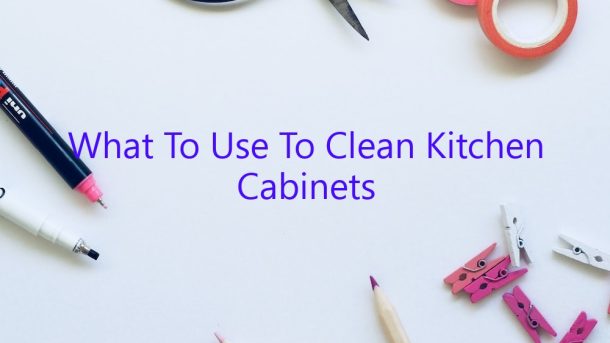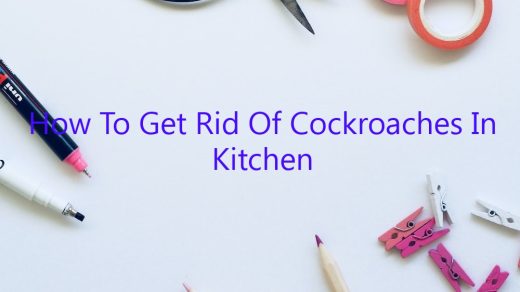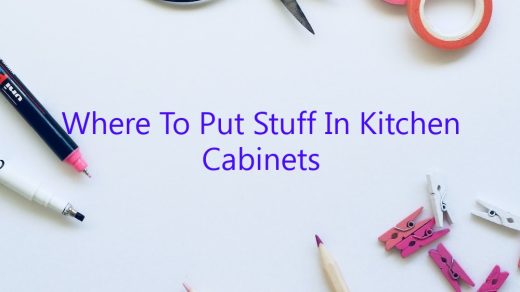The kitchen is one of the most-used rooms in the home, so it’s no surprise that it can also be one of the dirtiest. In addition to daily cooking and cleaning, airborne grease and dirt can settle on cabinets and create a grimy buildup over time.
Fortunately, cleaning kitchen cabinets is a relatively easy task. All you need is a few simple supplies and some elbow grease. Here are a few tips for how to clean kitchen cabinets:
1. Start by removing all of the contents of the cabinets and placing them on a nearby counter or table.
2. Next, use a dust cloth or a vacuum cleaner with the dust attachment to remove any excess dirt or dust from the cabinets.
3. If there is any grease or food residue on the cabinets, use a cleaning solution made of equal parts vinegar and water. Apply the solution to a clean cloth and wipe down the cabinets.
4. Finally, dry the cabinets with a clean cloth and put the contents back in.
Contents
- 1 How do you clean kitchen cabinets without removing the finish?
- 2 What is the best way to clean grease off kitchen cabinets?
- 3 How do you get grease and grime off wood cabinets?
- 4 Can I use Murphy Oil soap on kitchen cabinets?
- 5 Can you use Dawn dish soap on wood cabinets?
- 6 How can I make my kitchen cabinets look new again?
- 7 Why are my kitchen cabinets sticky after cleaning?
How do you clean kitchen cabinets without removing the finish?
If you’re looking for a way to clean your kitchen cabinets without removing the finish, you’re in luck. There are a few different methods you can use to clean your cabinets without damaging the finish.
One easy way to clean your cabinets is to use a damp rag. Simply dampen a rag with water and wipe down your cabinets. Be sure to use a soft cloth to avoid scratching the finish.
Another way to clean your cabinets is to use a vinegar and water solution. Mix equal parts vinegar and water in a spray bottle and spray the solution on your cabinets. Wipe the solution away with a soft cloth.
If you have a stubborn stain on your cabinets, you can use a baking soda and water paste to remove it. Mix baking soda and water to form a paste and apply it to the stain. Let the paste sit on the stain for a few minutes, then wipe it away with a damp cloth.
What is the best way to clean grease off kitchen cabinets?
Cleaning grease off kitchen cabinets can be a daunting task, but it doesn’t have to be. There are a few different ways that you can go about it, and each has its own set of pros and cons.
One way to clean grease off kitchen cabinets is to use a degreaser. Degreasers are specially formulated to break down grease and oil, and they can be very effective at getting the job done. However, degreasers can be harsh and can potentially damage your cabinets if they are used in excess.
Another way to clean grease off kitchen cabinets is to use a soap and water solution. This is a more gentle approach, and it is less likely to damage your cabinets. However, it may not be as effective at removing grease as a degreaser.
Ultimately, the best way to clean grease off kitchen cabinets will vary depending on the specific situation. If you are dealing with a lot of grease, a degreaser is likely to be the best option. If the grease is not as bad, a soap and water solution may be sufficient.
How do you get grease and grime off wood cabinets?
Grease and grime can be difficult to remove from wood cabinets, but with the right approach, it can be done. First, try to wipe away as much of the dirt and debris as possible with a damp cloth. Then, mix a solution of two tablespoons of white vinegar and one tablespoon of baking soda in a quart of warm water. Apply the solution to a cloth and wipe down the cabinets. The vinegar will help to break down the grease and grime, while the baking soda will help to remove any residual dirt or stains.
Can I use Murphy Oil soap on kitchen cabinets?
Murphy Oil soap is a versatile product that can be used for a variety of cleaning tasks. You may be wondering if it is safe to use Murphy Oil soap on kitchen cabinets.
The answer is yes, you can use Murphy Oil soap on kitchen cabinets. It is a great option for cleaning grease and grime build-up. Just be sure to test it in a small, inconspicuous area first to make sure it does not damage the finish on your cabinets.
Murphy Oil soap is a great choice for cleaning a variety of surfaces in the kitchen, including counters, appliances, and backsplashes. It is also a great choice for cleaning the inside of your oven.
Can you use Dawn dish soap on wood cabinets?
Can you use Dawn dish soap on wood cabinets? This is a question that has been asked by many homeowners who have wood cabinets in their kitchens. Dawn dish soap is a product that is known for its ability to clean dirty dishes, so it makes sense that some people might wonder if it can be used to clean their wood cabinets as well.
The answer to this question is yes, you can use Dawn dish soap on wood cabinets. However, it is important to note that Dawn dish soap is a detergent, and as such, it can be a bit harsh on wood. For this reason, it is best to use Dawn dish soap sparingly on wood cabinets, and to avoid using it on cabinets that are already damaged or worn.
If you do choose to use Dawn dish soap on your wood cabinets, be sure to follow these steps:
1. Thoroughly wet the surface of the cabinet with water.
2. Apply a small amount of Dawn dish soap to a damp cloth and wipe the cabinet down.
3. Rinse the cabinet with clean water and dry it thoroughly.
By following these steps, you can safely clean your wood cabinets with Dawn dish soap.
How can I make my kitchen cabinets look new again?
If your kitchen cabinets are starting to look a bit dated, there are several things you can do to give them a new lease of life. Whether you want to repaint them, replace the doors or just give them a good clean, there are plenty of options to make them look like new again.
The first step is to give them a good clean. Remove all of the contents of the cabinets and give them a good wipe down with a damp cloth. If there are any stubborn marks or dirt, you can use a mild detergent or a non-abrasive kitchen cleaner.
If your cabinets are in good condition but you just want to give them a new look, you can repaint them. You will need to sand them down first to remove any existing paint or varnish, and then you can apply a new coat. Choose a color that will complement your kitchen décor, or go for a completely different color to create a new look.
If the doors of your cabinets are in bad condition, you can replace them. This is a more expensive option, but it can be worth it if your cabinets are badly damaged or if you want to change the look of your kitchen. There are a wide range of door styles and colors to choose from, so you can find the perfect match for your kitchen.
If you want to give your cabinets a new look without spending a lot of money, you can replace the hardware. This is a particularly good option if the existing hardware is old and outdated. There are a wide range of hardware styles and colors to choose from, so you can find the perfect match for your kitchen.
Whatever option you choose, make sure you read the instructions carefully and follow the manufacturer’s instructions. This will help to ensure that your cabinets look like new again for many years to come.
Why are my kitchen cabinets sticky after cleaning?
Cleaning cabinets can be a difficult and frustrating task, but many people are surprised to find that their cabinets are still sticky after cleaning. So, what could be causing this and how can it be fixed?
There are a few potential reasons why your kitchen cabinets might be sticky after cleaning. The first possibility is that the cleaning products or solutions you used were not effective in removing all of the dirt, grease, or grime. If this is the case, you might need to try a different cleaning product or use a stronger solution.
Another possibility is that the adhesive or sealant on your cabinets is starting to wear off. Over time, this sealant can become brittle and crack, which can lead to a sticky surface. If this is the case, you might need to reseal your cabinets in order to get rid of the stickiness.
Finally, it is also possible that your cabinets were not properly cleaned in the first place. If this is the case, the dirt, grease, and grime might not have been removed completely, which can lead to a sticky surface after cleaning. Make sure to clean your cabinets thoroughly before trying to clean them again.
If your cabinets are still sticky after cleaning, try using a different cleaning product or solution, resealing your cabinets, or cleaning your cabinets more thoroughly. By addressing the underlying cause of the stickiness, you can hopefully get rid of the problem and have clean and functional cabinets once again.




